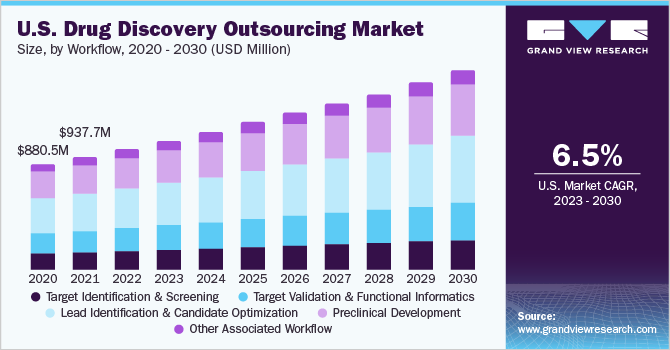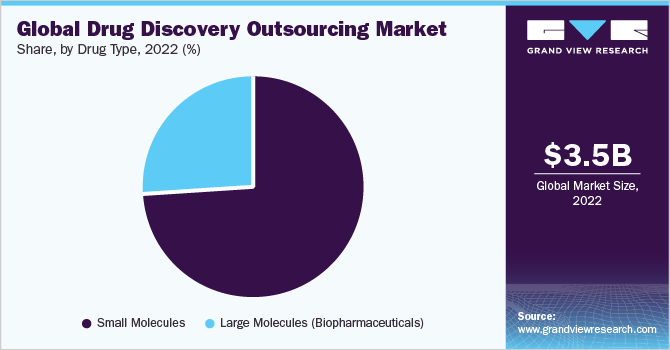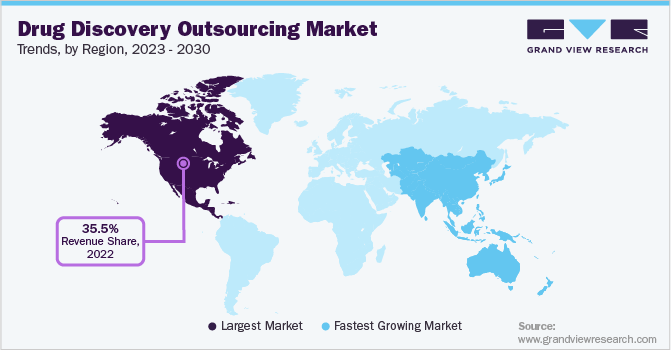- Home
- »
- Medical Devices
- »
-
Global Drug Discovery Outsourcing Market Size Report, 2030GVR Report cover
![Drug Discovery Outsourcing Market Size, Share & Trends Report]()
Drug Discovery Outsourcing Market Size, Share & Trends Analysis Report By Drug Type (Small, Large Molecules), By Workflow, By Therapeutics Area, By Service Type, By End-user, By Region, And Segment Forecasts, 2023 - 2030
- Report ID: GVR-2-68038-392-8
- Number of Report Pages: 187
- Format: PDF, Horizon Databook
- Historical Range: 2018 - 2021
- Forecast Period: 2023 - 2030
- Industry: Healthcare
Report Overview
The global drug discovery outsourcing market size was valued at USD 3.5 billion in 2022 and is anticipated to expand at a compound annual growth rate (CAGR) of 7.3% from 2023 to 2030. According to a survey conducted by Life Science Strategy Group of 120 clinical development decision-makers in the U. S., Europe, and China, industry professionals are undertaking major strategic changes to maintain their share in the unpredictable market scenario post COVID-19 pandemic. The pharmaceutical industry has witnessed radical changes in the past two decades, in terms of a shift toward biologics, patent expiration, and unprecedented downsizing of internal discovery of big pharmaceuticals. All of this has accelerated the adoption of outsourcing activities. Breaking down the different steps of drug discovery, such as hit confirmation, lead generation, lead optimization, and high-speed screening allows players to specialize in their core services.

An estimated 75.0% to 80.0% of R&D spending in the biopharmaceutical industry can be outsourced, creating opportunities for Contract Research Organizations (CROs), which, in turn is expected to boost the market growth. Pharmaceutical companies are partnering with manufacturing facilities in developing countries, which are backed by skilled manpower, low cost, and quality data. Cost-cutting, chasing innovation, gaining access to specialized knowledge and technology, and increasing speed and agility are some of the significant factors encouraging pharma companies to expand the level of outsourcing.
In return, it is expected to increase the competition among key players, leading to an emergence of various new startups across the hotspot regions, such as the U.S., China, India, South Korea, Singapore, and other Southeast Asian countries. For instance, in July 2018, Syngene International Ltd., a leading CRO based in India, extended its R&D collaboration with Baxter Healthcare Corporation until 2024. In March 2018, the company formed a multi-year agreement with GlaxoSmithKline (GSK) to accelerate the discovery of new drug candidates. The COVID-19 pandemic has slowed down various drug discovery processes due to the halting of various clinical trials.
However, on a brighter note, generous incentives are expected for pharmaceutical companies to invest in developing Infectious Diseases (ID) drugs and vaccines. Public health challenges in oncology, heart disease, and many other rare conditions still exist. For these, clinical research must go on. Here, CROs are expected to use their creativity to the fullest. With an urgent need for an effective vaccine/drug, companies are increasingly opting for outsourcing to enhance their clinical trials, which is expected to boost the market growth for several years.
Workflow Insights
Lead identification & candidate optimization dominated the workflow segment with a revenue share of more than 32.3% in 2022. Based on workflows, the market is segmented into target identification & screening, target validation & functional informatics, lead identification & candidate optimization, preclinical development, and other associated workflows. The iterative process of lead identification, also known as hit-to-lead, is a significant stage in early drug discovery. It has historically proven to have improved efficiencies and economies of scale for drug developers. The introduction of advanced in silico techniques to improve the lead identification process such as Computer-Aided Drug Discovery (CADD) and structure-based drug designs support the segment growth.
The rising need for skilled resources combined with knowledge of computer software, along with the high cost associated with the integration of the latest computation technology is enabling a higher outsourcing for lead identification services. Besides, the knowledge of metabolism and analytical chemistry play an important role in generating the need for these services. As a result, the lead identification and candidate optimization accounted for the largest share in terms of revenue in 2022. The other associated services segment which includes cell line development, upstream & downstream processes, analytical/bioanalytical methods, formulations & quality assessment, and regulatory assistance is anticipated to witness a rapid growth in the coming years. This is owing to an increased adoption of outsourcing services and high investments in drug discovery R&D.
Therapeutics Area Insights
The respiratory systems segment accounted for the largest share of over 14.0% of the global revenue in 2022. Based on therapeutic areas, the market is segmented into the respiratory system, pain and anesthesia oncology, ophthalmology, hematology, cardiovascular, endocrine, gastrointestinal, immunomodulation, anti-infective, central nervous system, dermatology, and genitourinary system. High incidence of respiratory disorders, such as bronchitis, tuberculosis, Chronic Obstructive Pulmonary Diseases (COPD), and asthma, coupled with increasing cases of drug resistance, has influenced the segment growth.
Furthermore, the introduction of novel drug delivery technologies, such as nasal sprays, has been identified to be the key contributor to the segment revenue. Lung diseases are responsible for over 700,000 hospital admissions and over 6 million inpatient bed-days in the U.K. per year. An estimated 1.2 million people are living with diagnosed COPD in the U.K. In view of this, in 2018, The University of Nottingham formed a strategic research collaboration with GSK and the University of Leicester. The collaboration is aimed at accelerating the discovery and development of innovative treatments for COPD. The oncology and anti-infective segments are both projected to witness significant CAGR in the forecast period.
Increased focus on the identification of novel targets to support cancer treatment contributes to the lucrative growth of the oncology segment. In June 2020, AstraZeneca collaborated with Accent Therapeutics to discover, develop, and commercialize transformative therapeutics targeting RNA-Modifying Proteins (RMPs) for the treatment of cancer. Accent will be responsible for R&D activities for a nominated preclinical program through to the end of Phase-I clinical trials. Antimicrobial resistance is projected to become a global crisis with its soaring rate of emergence and spread resulting in a high economic burden. Companies have increased R&D in anti-infective drugs, having identified the future need. This is poised to benefit the market growth.
Drug Type insights
The small molecules/pharmaceuticals segment accounted for the largest share of over 77.7% in 2022 and is projected to expand further at the fastest CAGR during the forecast period. Based on drug types, the market is classified into small and large molecules. Small molecules play a significant role in the development of innovative treatments for patients worldwide. Sales of half of the specialty medicines are attributable to small molecule applications. Its role is also visible in the recent approval trends. In 2019, the FDA approved 48 new drugs, 79% of which were composed of small molecules. Small molecules continue to play a vital role in the innovation of treatments across four key therapeutic areas: oncology, cardiovascular, autoimmune, and respiratory diseases.

Increased significance and highly effective components add up to the potential of small molecules in the pharmaceutical portfolio. Owing to this, the small molecules segment held the largest share in the market. Furthermore, the advantages of small molecules over larger ones have increased investments in the field, especially in cancer research. Small molecules can be administered orally, especially for the treatment of chronic diseases, they are cheaper, easy to manufacture, and can be combined with intracellular targets. Ongoing studies to investigate and develop novel therapeutics for various indications are expected to further influence segment growth.
Service Type insights
On the basis of service type, the market is segmented into chemistry services and biology services. The chemistry segment dominated the market, owing to increasing number of outsourcing projects for small molecules across the industry. Furthermore, the availability of drug discovery service providers offering high-quality services for drug chemical synthesis is increasing the demand for chemistry service outsourcing, particularly among small and midsized pharmaceutical companies lacking drug discovery research capabilities.
Biology services is expected to witness the fastest growth of 7.5% from 2023 to 2030. The growing demand for technical experts to conduct drug discovery services while abiding by regulatory requirements is one of the key factors promoting segment growth. Furthermore, the presence of a significant number of biology drug discovery service providers, such as Eurofins, Aurigene Pharmaceutical Services Ltd., and Syngene International Limited, is further supporting segment growth.
End-user Insights
The Pharmaceutical & Biotechnology Companiessegment accounted for the largest revenue share of over 79.8% in 2022 and is projected to register highest CAGR during the forecast period. High growth of the segment is majorly due to growing rate of pipeline therapeutics. Pharmaceutical R&D activities have improved globally over recent years. According to the Pharma R&D Annual Review 2022, the R&D drug count in 2020 was 18,582, while the R&D drug count in 2021 was 20,109 drugs. The growing R&D pipeline is expected to have a positive impact on the market. Furthermore, the burden of chronic and infectious diseases is rising steadily worldwide. The growing burden of these diseases is expected to increase the interest of pharmaceutical and biopharmaceutical companies in developing new drugs. This is further expected to promote market growth.
Regional Insights
North America dominated the market in 2022 and accounted for the largest share of more than 35.5% of the global revenue. The growth of the regional market can be attributed to the technological advancements, presence of well-established research infrastructure & key players, and higher investments in drug discovery R&D. With outsourcing no longer being solely about cost reduction, rising need for efficiency, quality, and innovation are expected to contribute to market growth. The Asia region is projected to register the fastest CAGR during the forecast period. The region is emerging as a hub for outsourcing drug discovery activities owing to the availability of skilled manpower, lower costs, favorable regulatory environment, and quality data.

Japan, being the second-largest pharmaceutical market at a global level, is expected to provide a robust opportunity for CROs, thus driving the market. The revised Pharmaceutical Affairs Law supports research activities regarding tissue diagnostics and cancer in Japan, which is expected to boost the market growth in this country. In 2015, the Japan Agency for Medical Research and Development (AMED) was established with an objective to manage data related to investigations and clinical trials, improve R&D infrastructure, and promote international strategies. This agency is an example of the initiatives taken to boost the market growth in Japan.
Key Companies & Market Share Insights
International partnerships are a key strategy witnessed among players. For instance, CROs in the U.K. are increasingly collaborating with players in the Swiss pharmaceutical sector. In addition, in a fragmented industry like pharmaceutical, agility becomes vital in the fast-moving drug discovery sector and this can be provided by quality service offerings along with a broad portfolio of capabilities. Thus, partnerships with Contract Development and Manufacturing Organizations (CDMOs) are preferred over Contract Manufacturing Organizations (CMOs). Some of the key players in the global drug discovery outsourcing market include:
-
Albany Molecular Research Inc.
-
EVOTEC
-
Laboratory Corporation of America Holdings
-
GenScript
-
Pharmaceutical Product Development, LLC
-
Charles River
-
WuXi AppTec
-
Merck & Co., Inc.
-
Thermo Fisher Scientific Inc.
-
Dalton Pharma Services
-
Oncodesign
-
Jubilant Biosys
-
DiscoverX Corp.
-
QIAGEN
-
Eurofins SE
-
Syngene International Limited
-
Dr. Reddy Laboratories Ltd.
-
Pharmaron Beijing Co., Ltd.
-
TCG Lifesciences Pvt Ltd.
-
Domainex Ltd.
Drug Discovery Outsourcing Market Report Scope
Report Attribute
Details
Market size value in 2023
USD 3.8 billion
Revenue forecast in 2030
USD 6.2 billion
Growth rate
CAGR of 7.3% from 2023 to 2030
Base year for estimation
2022
Historical data
2018 - 2021
Forecast period
2023 - 2030
Quantitative units
Revenue in USD million and CAGR from 2023 to 2030
Report coverage
Revenue forecast, company ranking, competitive landscape, growth factors, and trends
Segments covered
Workflow, therapeutics area, drug type, service type, end-user, region
Regional scope
North America; Europe; Asia Pacific; Latin America; Middle East & Africa
Country scope
U.S.; Canada; U.K.; Germany; France; Italy; Spain; Netherland; Belgium; Switzerland; Russia; Sweden; China; India; Japan; Thailand; Australia; South Korea; Malaysia; Indonesia; Singapore; Philippines; Colombia; Chile; Brazil; Mexico; Argentina; South Africa; Saudi Arabia; UAE; Kuwait; Egypt; Israel
Key companies profiled
Albany Molecular Research Inc.; EVOTEC; Laboratory Corporation of America Holdings; GenScript; Pharmaceutical Product Development, LLC; Charles River; WuXi AppTec; Merck & Co., Inc.; Thermo Fisher Scientific Inc.; Dalton Pharma Services; Oncodesign; Jubilant Biosys; DiscoverX Corp.; QIAGEN; Eurofins SE, Syngene International Limited; Dr. Reddy Laboratories Ltd., Pharmaron Beijing Co., Ltd.; TCG Lifesciences Pvt Ltd.; Domainex Ltd.
Customization scope
Free report customization (equivalent up to 8 analysts working days) with purchase. Addition or alteration to country, regional & segment scope.
Pricing and purchase options
Avail customized purchase options to meet your exact research needs. Explore purchase options
Global Drug Discovery Outsourcing Market Report Segmentation
This report forecasts revenue growth at the global, regional, and country levels and provides an analysis of the latest industry trends and opportunities in each of the sub-segments from 2018 to 2030. For the purpose of this study, Grand View Research has segmented the global Drug Discovery Outsourcing Market report based on workflow, therapeutics area, drug type, service type, end-user and region:
-
Workflow Outlook (Revenue, USD Million, 2018 - 2030)
-
Target Identification & Screening
-
Target Validation & Functional Informatics
-
Lead Identification & Candidate Optimization
-
Preclinical Development
-
Other Associated Workflow
-
-
Therapeutics Area Outlook (Revenue, USD Million, 2018 - 2030)
-
Respiratory system
-
Pain and Anesthesia
-
Oncology
-
Ophthalmology
-
Hematology
-
Cardiovascular
-
Endocrine
-
Gastrointestinal
-
Immunomodulation
-
Anti-infective
-
Central Nervous System
-
Dermatology
-
Genitourinary System
-
-
Drug Type Outlook (Revenue, USD Million, 2018 - 2030)
-
Small Molecules
-
Large Molecules (Biopharmaceuticals)
-
-
Service Type Outlook (Revenue, USD Million, 2018 - 2030)
-
Chemistry Services
-
Biology Services
-
-
End-user Outlook (Revenue, USD Million, 2018 - 2030)
-
Pharmaceutical & Biotechnology companies
-
Academic Institutes
-
Others
-
-
Regional Outlook (Revenue, USD Million, 2018 - 2030)
-
North America
-
U.S.
-
Canada
-
-
Europe
-
U.K.
-
Germany
-
Italy
-
France
-
Spain
-
Netherland
-
Belgium
-
Switzerland
-
Russia
-
Sweden
-
-
Asia Pacific
-
China
-
Japan
-
Australia
-
South Korea
-
India
-
Singapore
-
Philippines
-
Thailand
-
-
Latin America
-
Mexico
-
Brazil
-
Argentina
-
Chile
-
Colombia
-
-
Middle East & Africa
-
South Africa
-
Saudi Arabia
-
UAE
-
Kuwait
-
Israel
-
Egypt
-
-
Frequently Asked Questions About This Report
b. The global drug discovery outsourcing market size was estimated at USD 3.5 billion in 2022 and is expected to reach USD 3.8 billion in 2023.
b. The global drug discovery outsourcing market is expected to grow at a compound annual growth rate of 7.3% from 2023 to 2030 to reach USD 6.3 billion by 2030.
b. North America dominated the drug discovery outsourcing market with a share of 35.5% in 2022. This is attributable to the higher adoption of technological advancements, the presence of well-established research infrastructure, the presence of key players, and higher investments in drug discovery R&D.
b. Some key players operating in the drug discovery outsourcing market include Albany Molecular Research Inc.; EVOTEC; Laboratory Corporation of America Holdings; GenScript; Pharmaceutical Product Development, LLC; Charles River; WuXi AppTec; Merck & Co., Inc.; Thermo Fisher Scientific Inc.; Dalton Pharma Services; Oncodesign; Jubilant Biosys; DiscoverX Corporation; and QIAGEN.
b. Key factors that are driving the drug discovery outsourcing market growth include increasing trends of partnerships in drug discovery research; rising incidence rate of metabolic, genetic, and other chronic diseases; technology advancements in drug discovery.
Share this report with your colleague or friend.
![gvr icn]()
NEED A CUSTOM REPORT?
We can customize every report - free of charge - including purchasing stand-alone sections or country-level reports, as well as offer affordable discounts for start-ups & universities. Contact us now
![Certified Icon]()
We are GDPR and CCPA compliant! Your transaction & personal information is safe and secure. For more details, please read our privacy policy.
We are committed towards customer satisfaction, and quality service.
"The quality of research they have done for us has been excellent."





